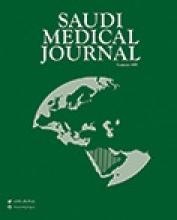Abstract
OBJECTIVE: To determine the prevalence of intestinal parasitic infections among primary school children in Dhahira region of Oman.
METHODS: The study took place in the Dhahira region of Oman from September 2004 to March 2005. We randomly recruited 436 students of 9-10 years of age. Their anthropometric measurements were noted. We collected the stool sample of each student and examined for different intestinal parasites. Stereoscopic microscopy and the World Health Organization's approved KATO-KATZ technique were used.
RESULTS: Of the 436 students examined, 65 children (15%) were undernourished (body mass index (BMI) <14 kg/m2). The prevalence of intestinal parasitic infections was 38.7% (95% CI 33.2-42.2). The prevalence of protozoan infection was 36% while helminth infection was 9.4%. The prevalence of Entamoeba histolytica/Entamoeba dispar was 24%, Giardia species 10.5% and Escherichia coli 1.4%. The hookworm (Ancylostoma duodenale, Necator americanus), Ascariasis lumbricoides, Trichuris trichiura, Hymenolepiasis nana, Taenia species, Enterobius vermicularis and Strongyloides infections in our study had very low prevalence. Only 29 (6.4%) students had parasitic infection by more than one parasite. The wet zone was significantly associated to the intestinal parasitic infections [Adjusted odds ratio (OR)=3.2 (95% CI 1.9-5.2)].
CONCLUSION: Dhahira region could be classified as low prevalence and low intensity area for soil transmitted helminths infections. However, the magnitude of the protozoan infection was high. The school health program should focus on parasitic infection treatment and addressing the underlying causes of this problem.
- Copyright: © Saudi Medical Journal
This is an open-access article distributed under the terms of the Creative Commons Attribution-Noncommercial-Share Alike 3.0 Unported, which permits unrestricted use, distribution, and reproduction in any medium, provided the original work is properly cited.






